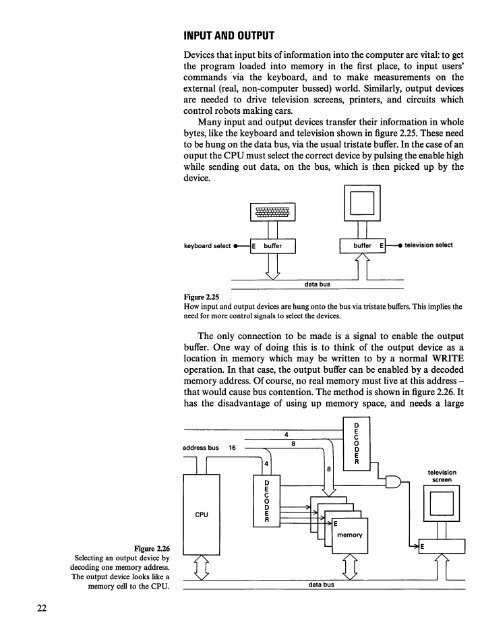Microcomputer Circuits and Processes
Microcomputer Circuits and Processes
Microcomputer Circuits and Processes
Create successful ePaper yourself
Turn your PDF publications into a flip-book with our unique Google optimized e-Paper software.
INPUT AND OUTPUT<br />
Devices that input bits of information into the computer are vital: to get<br />
the program loaded into memory in the first place, to input users'<br />
comm<strong>and</strong>s 'via the keyboard, <strong>and</strong> to make measurements on the<br />
external (real, no~-computer bussed) world. Similarly, output devices<br />
are needed to drive television screens, printers, <strong>and</strong> circuits which<br />
control robots making cars.<br />
Many input <strong>and</strong> output devices transfer their information in whole<br />
bytes, like the keyboard <strong>and</strong> television shown in figure 2.25. These need<br />
to be hung on the data bus, via the usual tristate buffer. In the case of an<br />
ouput the CPU must select the correct device by pulsing the enable high<br />
while sending out data, on the bus, which is then picked up by the<br />
device.<br />
D<br />
keyboard<br />
select<br />
television<br />
select<br />
data bus<br />
Figure 2.25<br />
How input <strong>and</strong> output devices are hung onto the bus via tristate buffers. This implies the<br />
need for more control signals to select the devices.<br />
The only connection to be made is a signal to enable the output<br />
buffer. One way of doing this is to think of the output device as a<br />
location in memory which may be written to by a normal WRITE<br />
operation. In that case, the output buffer can be enabled by a decoded<br />
memory address. Of course, no real memory must live at this address -<br />
that would cause bus contention. The method is shown in figure 2.26. It<br />
has the disadvantage of using up memory space, <strong>and</strong> needs a large<br />
address<br />
bus<br />
16<br />
4<br />
8<br />
CPU<br />
o<br />
E<br />
C<br />
o o<br />
E<br />
R<br />
television<br />
screen<br />
D<br />
Figure 2.26<br />
Selecting an output device by<br />
decoding one memory address.<br />
The output device looks like a<br />
memory cell to the CPU.<br />
22











